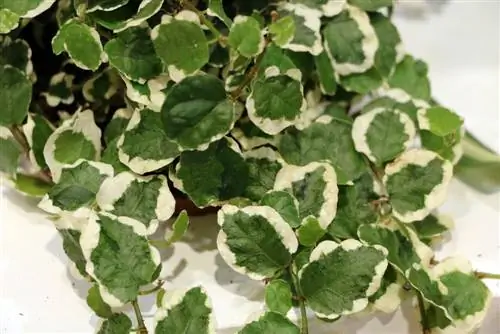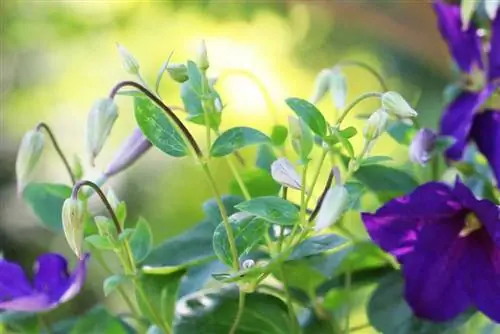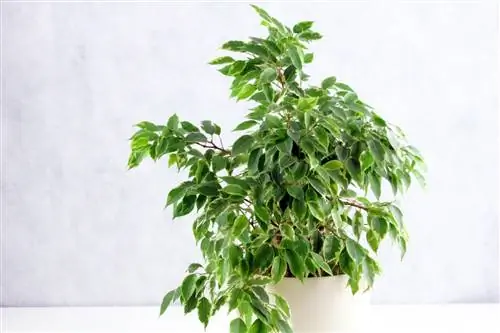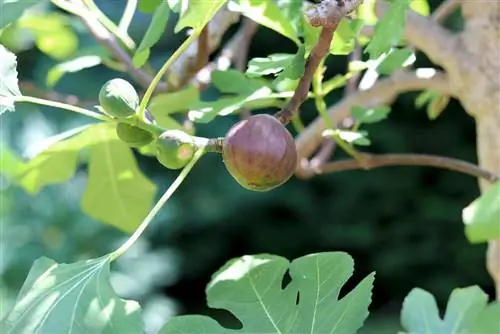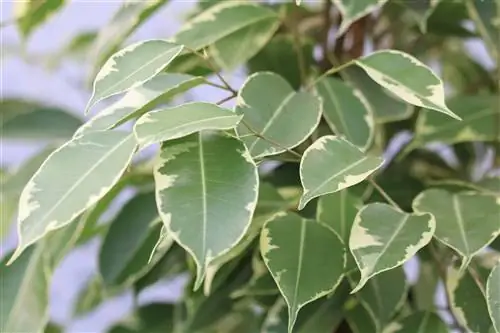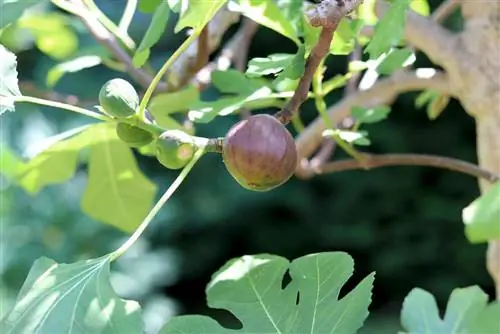- Author admin [email protected].
- Public 2023-12-17 03:39.
- Last modified 2025-01-24 12:45.
The climbing ficus is a climbing and climbing plant that is particularly used for greening walls and house walls. It can also be used as a houseplant. The climbing fig belongs to the mulberry family and requires little care.
Suitable location
The Ficus pumila prefers bright locations, such as partial shade or areas away from the sun. Intense, direct sunlight can burn the leaves. In summer, the climbing ficus can be accustomed to the midday sun, but a partially shaded spot is preferred. The plant can be left outside from spring to autumn. Potting soil is suitable as a substrate; if the plant is to be used as a houseplant, potting soil for green plants is recommended. Too low humidity can lead to pest infestation of houseplants. The most important things at a glance:
- A partially shaded spot away from the sun is ideal.
- The ficus should be protected from direct sun.
- The climbing ficus prefers normal potting soil.
- Houseplants are best planted in a substrate for green plants.
- Houseplants can be attacked by pests due to low humidity.
- Make sure that the humidity is sufficiently high, especially with houseplants.
Pouring
The plant should not be watered too much at once as it cannot tolerate waterlogging and the roots can rot. Dryness is also not recommended; it also results in root rot and brown leaf edges. When watering, only a little water is poured and then allowed to dry. At cooler temperatures, around 12 °C, you should water less. The most important information at a glance:
- Water only with a little water.
- The water should dry.
- Water less at low temperatures.
Planting and Propagation
The climbing ficus is best planted as a cutting or purchased as a plant. The cuttings can be put into the ground immediately and form roots very quickly. When planting cuttings, several plants should always be placed in one pot or in one place, so the ficus becomes particularly bushy. The cuttings ideally have a length of around 5 centimeters. When growing, the plant should be in a bright, but not directly sunny place. Temperatures above 18 °C ensure rapid growth. Houseplants can be grown open or covered with a clear plastic bag. The most important things about planting and propagation:
- Cuttings and purchased plants are suitable for planting.
- The cuttings can be placed in the ground immediately after cutting.
- The ideal length of the cuttings is about 5 centimeters.
- They form roots very quickly and are best grown at around 18-20 °C.
- The best place is a bright, partially shaded place.
- Houseplants can simply be left open or covered with a transparent bag.
Fertilize
The Ficus pumila is fertilized every four weeks in summer; green plant fertilizer in liquid form or in sticks is suitable here. If the plant stays outside in winter, fertilizing is not necessary. If it overwinteres in warm rooms at around 20 °C, it should be fertilized every four weeks with a fertilizer for house plants. The most important information about fertilizing:
- Liquid fertilizer or sticks are equally suitable for fertilizing.
- In summer and for houseplants, fertilizing every four weeks is recommended.
- You should not fertilize during wintering.
Wintering
The Ficus pumila is suitable as a year-round houseplant; it does not require any special care during the winter. Plants that are outside should be brought indoors to overwinter when temperatures are below 10 °C. Green-leaved plants can be overwintered cool at temperatures between 5 and 10 °C, while variegated-leaved plants need temperatures around 10 °C. During cool storage, the climbing ficus should only be watered a little and fertilizing should be avoided during this time. The most important thing about wintering:
- If temperatures are below 10 °C, the Ficus pumila should be brought inside.
- During cold overwintering, the plant is kept between 5-10 °C.
- Fertilizing should be avoided at low temperatures.
- The climbing ficus should only be watered lightly.
Implement
The climbing ficus should only be moved after about a year; plants that are kept outdoors only need to be moved at very low temperatures. The plant thrives best in monoculture; other plants, such as ivy, otherwise take away important nutrients from the climbing ficus. When moving the Ficus pumila, special attention should be paid to the roots, they are very sensitive and can quickly suffer damage. It is best to grow a new plant; this can simply be grown from a plant shoot. The most important information:
- The climbing ficus should only be moved after about a year.
- When repotting, pay attention to the roots.
- Plants kept outdoors should only be moved at low temperatures.
Pests
The climbing ficus can be attacked by mealybugs and spider mites. These pests mainly appear when the humidity is too low. In order to prevent an infestation, it is important to check the plant regularly. If the climbing ficus is infested with spider mites, the well-watered ficus can be covered with a plastic bag. The animals are killed and the plant can then recover. Insecticides in stick form can also be used against these pests, but they should only be used if the infestation is very severe. As a biological control option, naturally occurring fatty acids can be mixed with potassium s alts and then sprayed on the leaves. The underside of the leaves is particularly important here. Pest infestation can be effectively prevented by spraying the plant with water every day. The most important thing about pests at a glance:
- Spider mites and mealybugs most often attack the leaves.
- Sufficiently high humidity and regular checks on the leaves can prevent infestation.
- Biological control agents should be preferred over chemical ones.
- As a “first aid” the plant can be watered and then covered with a bag. The animals die within a few days and the ficus can recover.
Care tips in brief
- Ficus Repens likes to be bright, but not too sunny. Darker locations are also accepted.
- If the plant is too dark, the leaf spacing will be too large and the leaves will be too small.
- Room temperature is quite sufficient for these easy-care plants. The temperature should not fall below 15ºC.
- The plant develops best in moderately warm air and high humidity.
- The ideal potting soil is a mixture of loose humus soil with sand and peat additives.
- The climbing ficus doesn't like being too wet or cold. This leads to yellow spots on the edges of the leaves.
- In spring and summer, the Ficus Rebens is kept moderately moist. From October to February you water very sparingly. Waterlogging must be avoided at all costs. The plant is fertilized every two weeks in summer. When the ball is dry, the ficus sheds its leaves.
- Cutting off the shoot tips promotes branching. Otherwise, the climbing ficus does not need to be pruned. If the plant is balding from behind, it is best to pull a new plant from the shoot tips.
- The Ficus Repens is propagated by cuttings. The cut shoot pieces with 2 to 4 leaves root well in a water bottle in spring if it is warm and moist. Cuttings with aerial roots grow particularly quickly.

